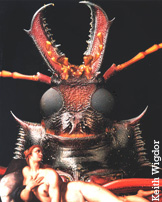April/May 2005

From Seraphim to Hallmark: The
Sexing-up of Angels
by Alexandra
Kogan
The
image of the angel is arguably one of modern man’s first usages
of sexuality to sell a commercial product, Christianity. As one of the
world’s younger religions, Christianity, fueled by the marketing
genius of St. Paul had to sell itself to millions who likely subscribed
to different theist viewpoints before the rise of the Church after the
fall of the Roman Empire.
The image of a tortured, agonized Christ, bleeding profusely from open
wounds was truly a hard-sell in the latter days of the Roman Empire,
when polytheism still dominated popular belief, peppered with its sterling
visions of beauty like Venus and Diana. Early Catholicism was more concerned
with wooing new followers; within a mere few centuries, they abandoned
this tactic, finding torture and mass murder far more effective means
of adding to their ranks.
In order to balance the gory, guilt-inducing image of Christ with something
less garish, something for the ladies (so to speak) an anonymous early
Christian public relations pioneer came up with the image of shapely
female (and male, to widen their appeal) angels to push their version
of heaven to potential converts. The underlying image conveyed by the
use of cherubic and voluptuous angels seems clear: dying as a good Christian
meant getting to spend eternity around beautiful people who always seem
happy to see you. Sex sells, even in heaven.
The sexing-up of the early Christian church was rather effective. Towards
the fall of the Roman Empire, the Catholic Church held greater dominion
over the citizens of the Empire than the Emperors themselves. Greed
and lust for dominion lead the Church to instigate some of the most
barbaric acts man has ever committed against man, yet the image of angels
acts as a thick screen of perfumed smoke over the Church’s many
sins. Similar to multi-national corporations that abuse workers, pollute
the environment and line the pockets of career politicians while hiding
behind candy-colored, family-friendly commercial imagery, the Church
has hid behind the subtle sexuality of the angel. The added benefit
of the angel is its perennially sensual allure. It is the ultimate centerfold
for the ultimate seduction: the ability to never again assume responsibility
for one’s own actions with mankind’s greatest crutch: God.
In terms of the destruction and defilement of the angel’s image,
as the angel was created to sell the product Christianity, its empty-vessel
versatility make its destruction its ultimate function. Combining the
disposability of commercial imagery with the staying power of sanctioned
imagery, if the parable of the seraphim is dismissed as mythology, angels
have no more meaning than any other one-dimensional image used predominately
to further an agenda. Commercial imagery is as inherently disposable
as the items that endorse, and the overriding purpose they serve is
clear: to sell products. Consumers are free to dismiss their validity
in one glance, while the brand-name item is jabbed into their subconscious
minds. Commercial imagery is a false creation stemming from nothing
more than ulterior motives.
The dichotomy between commercial imagery and angels exists predominately
in the sanctity ascribed to angels by the devout, who ascribe permanency
to an inherently disposable façade. As the Church relied upon
the mythological purity of the angel, their persistent use of this image
of supposed sanctity essentially cheapened the angel’s worth,
effectively defiling their own purportedly sacrosanct creation. The
angel is defiled further by its use to lure followers in through vaguely
sexual imagery. Its purity essentially is destroyed each time its image
is used to sugarcoat Christianity’s bloody beginnings in a more
palatable way than the crucified Christ likely could. Viewed in this
context, angels are no different than celebrities paid top dollar to
endorse consumer products, essentially making the Madonna and the whore
one in the same for all intents and purposes.
Free labor, and sex appeal that can be reproduced in stain glass in
cathedral windows or emblazoned across the cheap patina of a Hallmark
card, angels are the ultimate centerfolds. Disposable imagery that meets
a particular end, they epitomize perfection in order to ensure successful
seduction for over two millennia.
